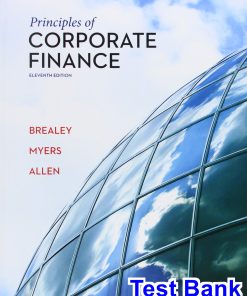Principles of Finance 6th Edition Besley Test Bank
You may also like
-
$26.50
$50.00
This is completed downloadable of Principles of Finance 6th Edition Besley Test Bank

Product Details:
- ISBN-10 : 1285429648
- ISBN-13 : 978-1285429649
- Author:
Develop the strong foundation in contemporary finance needed for success with PRINCIPLES OF FINANCE, 6E by leading authors Besley and Brigham. This practical book addresses today’s most relevant financial concepts as readers examine current financial markets and institutions, investments, and managerial finance. This edition is more practical than ever before with revised presentations that further clarify time value of money and other complex concepts. When relevant, this edition discusses the impact of the 2007-2009 financial market meltdown on finance today and connects topics to reader’s personal finance decisions. Reader clearly see how concepts influence both immediate and long-term common financial decisions and increase their proficiency in using spreadsheets for financial decisions and financial problem solving.
Table of Content:
- Part 1: General Finance Concepts
- Ch 1: An Overview of Finance
- What is Finance?
- General Areas of Finance
- The Importance of Finance in Nonfinance Areas
- The Evolution of Modern Finance
- The Importance of Managerial Finance
- Financial Decisions and Value (Wealth) Maximization
- Recent (Future) Developments in Business and Finance
- Questions
- Problem
- Ch 2: Financial Assets (Instruments)
- Financial Instruments and the Firm’s Balance Sheet
- Debt
- Bond Contract Features
- Bond Ratings
- Stock (Equity)
- Derivatives
- Rationale for Different Types of Securities
- Which Financial Instrument is Best?
- Financial Instruments in International Markets
- Questions
- Problems
- Appendix 2A
- Ch 3: Financial Markets and the Investment Banking Process
- What are Financial Markets?
- Importance of Financial Markets
- Types of Financial Markets
- The Investment Banking Process
- Regulation of Securities Markets
- International Financial Markets
- Questions
- Problems
- Computer-Related Problem
- Appendix 3A
- Ch 4: Financial Intermediaries and the Banking System
- Roles of Financial Intermediaries
- Types of Financial Intermediaries
- Safety (Risk) of Financial Institutions
- Banking Systems
- International Banking
- Questions
- Problems
- Appendix 4A
- Ch 5: The Cost of Money (Interest Rates)
- Realized Returns (Yields)
- Factors That Affect the Cost of Money
- Interest Rate Levels
- Determinants of Market Interest Rates
- The Term Structure of Interest Rates
- Why Do Yield Curves Differ?
- Does the Yield Curve Indicate Future Interest Rates?
- Other Factors That Influence Interest Rate Levels
- Interest Rate Levels and Stock Prices
- The Cost of Money as a Determinant of Value
- Questions
- Problems
- Computer-Related Problem
- Appendix 5A
- Part 2: General Business Concepts
- Ch 6: Business Organizations and the Tax Environment
- Alternative Forms of Business Organization
- Finance in the Organizational Structure of the Firm
- What Goal(s) Should Businesses Pursue?
- Managerial Actions to Maximize Shareholder Wealth
- Should Earnings per Share (EPS) Be Maximized?
- Managers’ Roles as Agents of Stockholders
- Stockholders’ Roles as Agents of Creditors
- Business Ethics
- Corporate Governance
- Forms of Businesses in Other Countries
- Multinational Corporations
- Multinational versus Domestic Managerial Finance
- The Federal Income Tax System
- Corporate Tax Rates in Other Countries
- Questions
- Problems
- Computer-Related Problem
- Appendix 6A
- Appendix 6B
- Ch 7: Analysis of Financial Statements
- Recording Business Activity-Financial Statements
- Financial Statements
- Financial Statement (Ratio) Analysis
- Summary of Ratio Analysis: The DuPont Analysis
- Comparative Ratios (Benchmarking)
- Uses and Limitations of Ratio Analysis
- Accounting in an International Setting
- Questions
- Problems
- Computer-Related Problem
- Appendix 7A
- Ch 8: Financial Planning and Control
- Sales Forecasts
- Projected (Pro Forma) Financial Statements
- Other Considerations in Forecasting
- Financial Control-Budgeting and Leverage
- Breakeven Analysis
- Leverage
- Using Leverage and Forecasting for Control
- The Cash Budget
- Questions
- Problems
- Computer-Related Problem
- Appendix 8A
- Appendix 8B
- Part 3: Fundamentals of Valuation
- Ch 9: Time Value of Money
- Cash Flow Timelines
- Cash Flow Patterns
- Future Value (FV)
- Present Value (PV)
- Comparison of Future Value with Present Value
- Solving for Interest Rates (r), Time (n), or Annuity Payments (PMT)
- Semiannual and Other Compounding Periods
- Comparison of Different Interest Rates
- Amortized Loans
- Questions
- Problems
- Computer-Related Problem
- Appendix 9A
- Appendix 9B
- Ch 10: Valuation Concepts
- Basic Valuation
- Valuation of Bonds
- Finding Bond Yields (Market Rates)
- Interest Rates and Bond Values
- Changes in Bond Values over Time
- Bond Values with Semiannual Compounding
- Interest Rate Risk on a Bond
- Bond Prices in Recent Years
- Valuation of Equity (Stock)
- Expected Dividends as the Basis for Stock Values
- Actual Stock Prices and Returns in Recent Years
- Questions
- Problems
- Computer-Related Problem
- Appendix 10A
- Ch 11: Risk and Rates of Return
- Defining and Measuring Risk
- Expected Rate of Return
- Portfolio Risk-Holding Combinations of Assets
- The Concept of Beta
- The Relationship between Risk and Rates of Return-The Capital Asset Pricing Model (CAPM)
- Stock Market Equilibrium
- Changes in Equilibrium Stock Prices
- Physical Assets versus Securities
- Different Types of Risk
- Questions
- Problems
- Computer-Related Problem
- Appendix 11A
- Part 4: Corporate Decision Making
- Ch 12: The Cost of Capital
- The Logic of the Weighted Average Cost of Capital (WACC)
- Basic Definitions
- Cost of Debt, rdT
- Cost of Preferred Stock, rps
- Cost of Retained Earnings (Internal Equity), rs
- Cost of Newly Issued Common Stock (External Equity), re
- Weighted Average Cost of Capital (WACC)
- The Marginal Cost of Capital (MCC)
- Combining the MCC and Investment Opportunity Schedules (IOS)
- Project Risk and WACC
- WACC versus Required Rate of Return of Investors
- Questions
- Problems
- Computer-Related Problem
- Appendix 12A
- Ch 13: Capital Budgeting
- The Importance of Capital Budgeting
- Project Classifications
- Steps in the Valuation Process
- Estimating a Project’s Cash Flows
- Cash Flow Estimation-Illustrations of Expansion Projects and Replacement Projects
- Capital Budgeting Evaluation Techniques
- Comparison of the NPV and IRR Methods
- Cash Flow Patterns and Multiple IRRs
- Modified Internal Rate of Return
- Conclusions on the Capital Budgeting Decision Methods
- Incorporating Risk in Capital Budgeting Analysis
- How Project Risk is Considered in Capital Budgeting Decisions
- Multinational Capital Budgeting
- Questions
- Problems
- Computer-Related Problem
- Appendix 13A
- Problem
- Appendix 13B
- Appendix 13C
- Ch 14: Capital Structure and Dividend Policy Decisions
- The Target Capital Structure
- Business and Financial Risk
- Determining the Optimal Capital Structure
- Liquidity and Capital Structure
- Capital Structure Theory
- Variations in Capital Structures among Firms
- Dividend Policy
- Investors and Dividend Policy
- Dividend Policy in Practice
- Factors Influencing Dividend Policy
- Stock Dividends and Stock Splits
- Capital Structures and Dividend Policies around the World
- Questions
- Problems
- Computer-Related Problems
- Appendix 14A
- Ch 15: Working Capital Management
- Working Capital Terminology
- The Requirement for External Working Capital Financing
- The Cash Conversion Cycle
- Working Capital Investment and Financing Policies
- Advantages and Disadvantages of Short-Term Financing
- Sources of Short-Term Financing
- Computing the Cost of Short-Term Credit
- Managing Cash and Marketable Securities
- Credit Management
- Inventory Management
- Multinational Working Capital Management
- Questions
- Problems
- Computer-Related Problem
- Appendix 15A
- Part 5: Investor Decision Making
- Ch 16: Investment Concepts
- The Investment Process
- Investment Alternatives
- Securities Transactions
- Investment Information
- Computing Investment Returns
- Indexes-Measuring Market Returns
- Alternative Investment Strategies
- Questions
- Problems
- Computer-Related Problem
- Appendix 16A
- Ch 17: Security Valuation and Selection
- Fundamental Analysis versus Technical Analysis
- Economic Analysis
- Industry Analysis
- Evaluating the Firm’s Financial Position
- Stock Valuation Techniques
- Technical Analysis
- Stock Selection Criteria
- Investment Selection in Efficient Markets
- Questions
- Problems
- Computer-Related Problem
- Appendix 17A
- Appendix A: Using Spreadsheets to Solve Financial Problems
- Appendix B: Answers to End-of-Chapter Problems
- Appendix C: Selected Equations
- Index
People Also Search:
principles of finance besley
principles of finance 6th edition besley
principles of finance
principles of finance 6th edition
principles of finance 6th edition download scribd
principles of finance 6th edition testbank download pdf
principles of finance 6th edition besley pdf free












